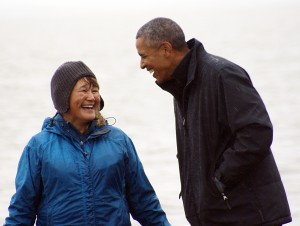
President Obama began his tour of Western Alaska with a stop in Bristol Bay, landing in Dillingham just before noon. While Obama had sparkling clear weather for his tour around Seward yesterday, it was drizzly and a little chilly for the duration of the Dillingham stop. No mind, say residents: that’s what fishing weather is usually like in the region, and fishing was the main thing locals wanted the President to know more about while he was in salmon country.
Past presidents have come to Bristol Bay, usually for the world-class sportfishing.
But the crowds were pumped as President Obama landed on Air Force One in this rural corner of Alaska Wednesday. Simuka Smith was at the airport, hoping to get a chance to shake the president’s hand.
“I mean this is the most excitement we’ve had and maybe we’ll get some of our issues taken care of, with Pebble mine and drilling…. I hope he sees the beauty of the town and the area.”
Despite the rain, people waited on every corner and driveway to welcome the motorcade. Many waved flags and hand-painted signs.
The first stop was Dillingham’s Kanakanak Beach, a spot where generations of families have put out their subsistence fishing nets each summer. There, at low tide, the President put on fish-picking gloves and helped pick some pink salmon – known as humpies – from the net. As he held one up for a photo-op, he got a slimy surprise…
“Did you see that? Something got on my shoes! *laughter* It was spawning a little bit.”
That’s right: a Bristol Bay salmon shot its milt on Barack Obama’s hiking boot Wednesday.
Organizers hoped to have Obama cut fish as well, but the Secret Service nixed the necessary sharp knives. Instead he ate some traditional salmon strips and was given a jar of smoked salmon to take home.
Mr. Obama didn’t take any questions from the press, but offered brief remarks from the beach.
“Even though we’ve got a cloudy day, I think everybody has a sense of how beautiful this place is. And the scale of fish that come through here is remarkable. If you catch — or if you’ve eaten wild salmon, it’s likely to have come from here.”
Fifty-eight million sockeye returned to Bristol Bay this summer: the third largest return on record.
While calling attention to the effects of climate change has been the theme of Obama’s trip to Alaska, in Bristol Bay he simply put a spotlight on the ecosystem that supports one of the healthiest fisheries on the planet. He called Bristol Bay one of the United States’ most important natural resources:
“This is one of the reasons why we have shut off oil and gas exploration in this region. It is too fragile, and it is too important –”
The president was interrupted by applause and ‘thank yous’ from the crowd.
” — for us to be able to endanger it in any sort of way.”
The President noticeably did not mention Pebble, a proposed copper and gold mine in the headwaters of the Bristol Bay watershed.
Under Obama, the Environmental Protection Agency has proposed pre-emptive restrictions that would block the mine’s development. While the EPA’s efforts have been praised by many in the region, the Pebble Partnership has sued the agency three times in federal court, the latest suit alleging violations of open government rules.
Lisa Reimers of the Iliamna Development Corporation is among those who want the mine to be considered as an economic opportunity. Her village is much nearer to Pebble’s deposit, but she knows the message she hoped to convey to Obama on Wednesday is not popular in Dillingham.
“I see that we’re up against huge environmental groups, big government, and we sometimes feel that we’re pushed aside, even though that’s our home and we want to let it go through due process. Nobody wants to hear that.”
But for most, the President’s message about preserving the fishery was spot on.
Alannah Hurley is the director of a group of local tribal councils.
“He definitely spoke to the heart of this region, he recognizes how unique our region is, how important salmon are to the Yup’ik, Dena’ina and Alutiiq people… and he respects that.”
Obama’s time at Kanakanak Beach was closed off to all but a small group, more or less all members of one well-connected family. That was a sore spot of Wednesday’s visit for some.
But the President went from the beach to Dillingham Middle School, where he watched – and even joined in – traditional dances put on by young students. He shook a lot of hands and mingled before he left on his way to Kotzebue.
It was a unique moment for a remote rural place and people who live off the road system; and while the messaging was important, Dante Luckhurst reminded that there’s more to meeting the President than just listening to what he has to say:
“We got to see a lot of cops. We saw a lot of black cars and army men,” Luckhurst says. “And we seen a good plane flying by that the President was in.”
That this small town certainly did.
Hannah Colton is a reporter at a in Dillingham.




